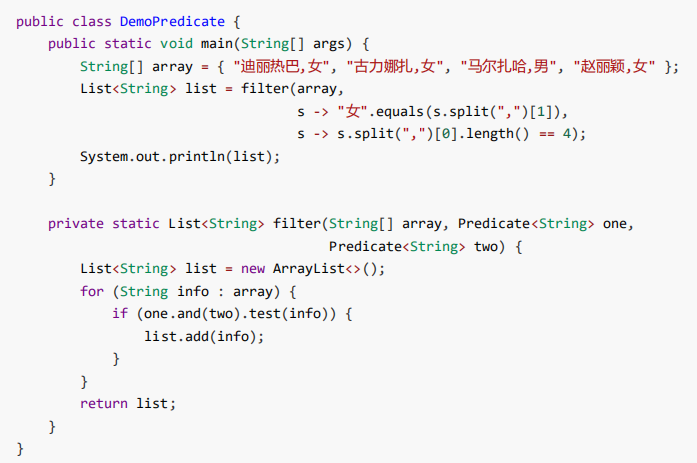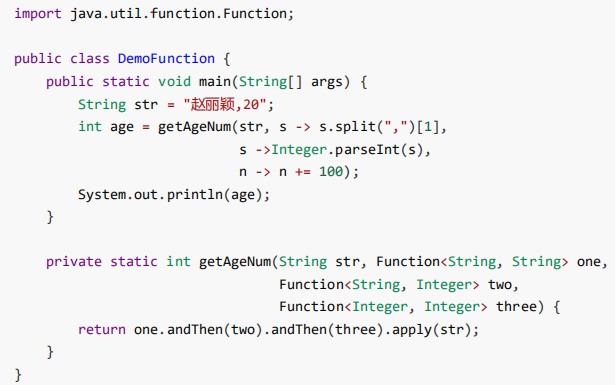主要内容
- 自定义函数式接口
- 函数式编程
- 常用函数式接口
学习目标
- 能够使用@FunctionalInterface注解
- 能够自定义函数式接口
- 能够理解Lambda延迟执行的特点
- 能够使用Lambda作为方法的参数
- 能够使用Lambda作为方法的返回值
- 能够使用Supplier函数式接口
- 能够使用Consumer函数式接口
- 能够使用Function函数式接口
- 能够使用Predicate函数式接口
一、函数式接口
概念
函数式接口在Java中是指:有且仅有一个抽象方法(被abstract修饰)的接口。
函数式接口,即适用于函数式编程场景的接口。而Java中的函数式编程体现就是Lambda,所以函数式接口就是可
以适用于Lambda使用的接口。只有确保接口中有且仅有一个抽象方法,Java中的Lambda才能顺利地进行推导。备注:“语法糖”是指使用更加方便,但是原理不变的代码语法。例如在遍历集合时使用的for-each语法,其实 底层的实现原理仍然是迭代器,这便是“语法糖”。从应用层面来讲,Java中的Lambda可以被当做是匿名内部 类的“语法糖”,但是二者在原理上是不同的。
格式
只要确保接口中有且仅有一个抽象方法即可:
修饰符 interface 接口名称 {public abstract 返回值类型 方法名称(可选参数信息);// 其他非抽象方法内容}
由于接口当中抽象方法的 public abstract 是可以省略的,所以定义一个函数式接口很简单:
public interface MyFunctionalInterface {void myMethod(); //接口中的方法都是抽象方法,所以public abstract可以省略}
_@_FunctionalInterface 注解(装饰器)
与 _@_Override 注解的作用类似,Java 8中专门为函数式接口引入了一个新的注解: _@_FunctionalInterface 。该注
解可用于一个接口的定义上:
@FunctionalInterfacepublic interface MyFunctionalInterface {void myMethod();}
一旦使用该注解来定义接口,编译器将会强制检查该接口是否确实有且仅有一个抽象方法,否则将会报错。需要注
意的是,即使不使用该注解,只要满足函数式接口的定义,这仍然是一个函数式接口,使用起来都一样。
自定义函数式接口
对于刚刚定义好的 MyFunctionalInterface 函数式接口,典型使用场景就是作为方法的参数:
//自定义函数式接口(只有一个抽象方法)@FunctionalInterfacepublic interface MyFuncInterface {void MyMethod();}public class Demo01 {//使用自定义的函数式接口作为方法参数private static void doSomething(MyFuncInterface funcinter){funcinter.MyMethod();}public static void main(String[] args) {//调用函数式接口的方法doSomething(() ->{System.out.println("自定义函数式接口的lambda方法执行了");});}}
二、函数式编程
在兼顾面向对象特性的基础上,Java语言通过Lambda表达式与方法引用等,为开发者打开了函数式编程的大门。
下面我们做一个初探。
1.Lambda的延迟执行
有些场景的代码执行后,结果不一定会被使用但还是编译执行了,从而造成性能浪费。而Lambda表达式是延迟执行的,这正好可以 作为解决方案,提升性能。
性能浪费的日志案例
注:日志可以帮助我们快速的定位问题,记录程序运行过程中的情况,以便项目的监控和优化。 一种典型的场景就是对参数进行有条件使用,例如对日志消息进行拼接后,在满足条件的情况下进行打印输出:
private static void log(int level, String msg) {if (level == 1) {System.out.println(msg);}}//使用lambdaprivate static void LambdaLog(int level,BuildMessage builder){System.out.println("调用日志方法");//执行到这里,判断level == 1,如果不等于lambda中的函数体不执行if (level == 1){System.out.println(builder.buildMsg());}}public static void main(String[] args) {String msgA = "Hello";String msgB = "World";String msgC = "Java";log(1, msgA + msgB + msgC); //无论level ==1字符串都进行了拼接,造成性能浪费//lambda延迟执行LambdaLog(2, () ->{System.out.println("lambda方法拼接字符串");return msgA + msgB + msgC;});}
这段代码存在问题:无论级别是否满足要求,作为 log 方法的第二个参数,三个字符串一定会首先被拼接并传入方
法内,然后才会进行级别判断。如果级别不符合要求,那么字符串的拼接操作就白做了,存在性能浪费。
备注:SLF4J是应用非常广泛的日志框架,它在记录日志时为了解决这种性能浪费的问题,并不推荐首先进行 字符串的拼接,而是将字符串的若干部分作为可变参数传入方法中,仅在日志级别满足要求的情况下才会进 行字符串拼接。例如: LOGGER.debug(“变量{}的取值为{}”, “os”, “macOS”) ,其中的大括号 {} 为占位 符。如果满足日志级别要求,则会将“os”和“macOS”两个字符串依次拼接到大括号的位置;否则不会进行字 符串拼接。这也是一种可行解决方案,但Lambda可以做到更好。
定义函数式接口:
@FunctionalInterfacepublic interface BuildMessage {String buildMsg();}
这样一来,只有当级别满足要求的时候,才会进行三个字符串的拼接;否则三个字符串将不会进行拼接。
2.Lambda作为参数和返回值
如果抛开实现原理不说,Java中的Lambda表达式可以被当作是匿名内部类的替代品。如果方法的参数是一个函数
式接口类型,那么就可以使用Lambda表达式进行替代。使用Lambda表达式作为方法参数,其实就是使用函数式
接口作为方法参数。
例如 java.lang.Runnable 接口就是一个函数式接口,假设有一个startThread 方法使用该接口作为参数,那么就 可以使用Lambda进行传参。这种情况其实和 Thread 类的构造方法参数为 Runnable 没有本质区别。
public class Demo04Runnable {private static void startThread(Runnable task) {new Thread(task).start();}public static void main(String[] args) {startThread(() ‐> System.out.println("线程任务执行!"));}}
类似地,如果一个方法的返回值类型是一个函数式接口,那么就可以直接返回一个Lambda表达式。当需要通过一
个方法来获取一个 java.util.Comparator接口类型的对象作为排序器时,就可以调该方法获取。
public class Demo06Comparator {private static Comparator<String> newComparator() { //返回一个比较器类型return (a,b) ‐>b.length() ‐a.length();}public static void main(String[] args) {String[] array = {"abc", "ab", "abcd"};System.out.println(Arrays.toString(array));Arrays.sort(array, newComparator());System.out.println(Arrays.toString(array));}}
三、常用函数式接口
JDK提供了大量常用的函数式接口以丰富Lambda的典型使用场景,它们主要在 java.util.function 包中被提供。 下面是最简单的几个接口及使用示例。
1.Supplier接口
java.util.function.Supplier<T> 接口仅包含一个无参的方法:T get() 。用来获取一个泛型参数指定类型的对 象数据。由于这是一个函数式接口,这也就意味着对应的Lambda表达式需要“对外提供”一个符合泛型类型的对象数据。
public class Demo01Supplier {public static void main(String[] args) {String msgA = "hello";String msgB = "world";System.out.println(getString(()->{return msgA+msgB;}));}private static String getString(Supplier<String> func) {return func.get();}}
练习:求数组元素最大值
题目
使用 Supplier 接口作为方法参数类型,通过Lambda表达式求出int数组中的最大值。提示:接口的泛型请使用java.lang.Integer 类。
解答
public class MaxValueArr {public static void main(String[] args) {int[] arr = {2,3,5,9,12,65,32};int maxNum = getMax(()->{int max = arr[0];for (int i : arr) {if(i>max){max = i;}}return max;});System.out.println("arr中max="+maxNum);}private static int getMax(Supplier<Integer> func) {return func.get();}}
2.Consumer接口
java.util.function.Consumer<T> 接口则正好与Supplier接口相反,它不是生产一个数据,而是消费一个数据,其数据类型由泛型决定。
抽象方法:accept
Consumer 接口中包含抽象方法 void accept(T t) ,意为消费一个指定泛型的数据。基本使用如:
//jdk8用法Consumer<String> consumer = new Consumer<>() {@Overridepublic void accept(String s) {System.out.println("s="+s);}};//lambda写法Consumer<String> consumer = s -> System.out.println("s="+s);consumer.accept("hello world");//andThen链式调用Consumer<String> consumer1 = s -> {s+=" xiong";System.out.println("s="+s);};Consumer<String> consumer2 = s -> {s+=" world"; //接收的s还是accept传入的参数System.out.println("s="+s);};consumer1.andThen(consumer2).accept("Justin");
当然还可以将lambda方法写到Consumer中,像调用普通函数一样
public static void main(String[] args) {consumerStr();testAndThen();}private static void consumerStr() {Consumer<Integer> function = x->{System.out.println("x*x="+x*x);};function.accept(2);}/*** 定义3个Consumer并按顺序进行调用andThen方法,其中consumer2抛出NullPointerException。*/public static void testAndThen(){Consumer<Integer> consumer1 = x -> System.out.println("first x : " + x);Consumer<Integer> consumer2 = x -> {System.out.println("second x : " + x);throw new NullPointerException("throw exception test"); //抛出异常};Consumer<Integer> consumer3 = x -> System.out.println("third x : " + x);//consumer2执行完抛出异常,consumer3未执行consumer1.andThen(consumer2).andThen(consumer3).accept(1);}
练习:打印集合列表的每一项item信息
定义一个Employee类
arr.forEach(Consumer<? super T> action) 传入Consumer
private static final List<Employee> employees = Arrays.asList(new Employee(1,"zhangsan"),new Employee(2,"lisi"),new Employee(3,"wagnwu"));public static void main(String[] args) {Consumer<Employee> consumer = employee -> System.out.println(employee);employees.forEach(consumer);}//打印//Employee{id=1, name='zhangsan'}//Employee{id=2, name='lisi'}//Employee{id=3, name='wagnwu'}
练习:格式化打印信息
题目
下面的字符串数组当中存有多条信息,请按照格式“ 姓名:XX。性别:XX。 ”的格式将信息打印出来。要求将打印姓 名的动作作为第一个 Consumer 接口的Lambda实例,将打印性别的动作作为第二个 Consumer 接口的Lambda实 例,将两个 Consumer 接口按照顺序“拼接”到一起。
public class FormatInfo {public static void main(String[] args) {String[] array = { "迪丽热巴,女", "古力娜扎,女", "马尔扎哈,男" };printInfo(array,s -> System.out.println("姓名:"+s.split(",")[0]),s -> System.out.println("性别:"+s.split(",")[1]));}private static void printInfo(String[] array,Consumer<String> con1,Consumer<String> con2) {for (String s : array) {con1.andThen(con2).accept(s);}}}
打印:
姓名:迪丽热巴 性别:女 姓名:古力娜扎 性别:女 姓名:马尔扎哈 性别:男
3.Predicate接口
有时候我们需要对某种类型的数据进行判断,从而得到一个boolean值结果。这时可以使用java.util.function.Predicate<T> 接口。
抽象方法:test
Predicate 接口中包含一个抽象方法:boolean test(T t)。用于条件判断的场景:
public class Demo01Predicate {public static void main(String[] args) {String str = "hello world";strIsLong(str,s -> {return s.length()>20;});}private static void strIsLong(String str,Predicate<String> pre){boolean isLong = pre.test(str); //pre.test(str) 结果就是lambda返回值System.out.println(str+"字符串长吗? "+isLong);}}
条件判断的标准是传入的Lambda表达式逻辑,只要字符串长度大于20则认为很长。
默认方法:and
既然是条件判断,就会存在与、或、非三种常见的逻辑关系。其中将两个 Predicate 条件使用“与”逻辑连接起来实
现“并且”的效果时,可以使用default方法 and 。其JDK源码为
default Predicate<T> and(Predicate<? super T> other) {Objects.requireNonNull(other);return (t) ‐> test(t) && other.test(t);}
如果要判断一个字符串既要包含大写“H”,又要包含大写“W”,那么:
public static void main(String[] args) {PredicateAnd("HelloWorld",s -> s.contains("H"),s -> s.contains("W"));}private static void PredicateAnd(String str,Predicate<String> one,Predicate<String> two){boolean isValid = one.and(two).test(str);System.out.println("字符串符合要求吗? "+isValid);}
默认方法:or
与 and 的“与”类似,默认方法 or 实现逻辑关系中的“或”。JDK源码为:
default Predicate<T> or(Predicate<? super T> other) {Objects.requireNonNull(other);return (t) ‐> test(t) || other.test(t);}
如果希望实现逻辑“字符串包含大写H或者包含大写W”,那么代码只需要将“and”修改为“or”名称即可,其他都不
变:
public static void main(String[] args) {PredicateOr("HelloWorld",s -> s.contains("H"),s -> s.contains("W"));}private static void PredicateOr(String str,Predicate<String> one,Predicate<String> two){boolean isValid = one.or(two).test(str);System.out.println("字符串符合要求吗? "+isValid);}
默认方法:negate
“与”、“或”已经了解了,剩下的“非”(取反)也会简单。默认方法 negate 的JDK源代码为:
default Predicate<T> negate() {return (t) ‐> !test(t);}
从实现中很容易看出,它是执行了test方法之后,对结果boolean值进行“!”取反而已。一定要在 test 方法调用之前
调用 negate 方法,正如 and 和 or 方法一样:
public static void main(String[] args) {//非,判断一个字符串包含大写“H”的情况取反PredicateNegate("HelloWorld",s -> s.contains("H"));}private static void PredicateNegate(String str,Predicate<String> one){boolean isValid = one.negate().test(str);System.out.println("negate字符串符合要求吗? "+isValid);}
练习:集合信息筛选
题目
数组当中有多条“姓名+性别”的信息如下,请通过 Predicate 接口的拼装将符合要求的字符串筛选到集合
ArrayList 中,需要同时满足两个条件:
- 必须为女生;
- 姓名为4个字。
public class Test01Predicate {public static void main(String[] args) {String[] array = { "迪丽热巴,女", "古力娜扎,女", "马尔扎哈,男", "赵丽颖,女" };List<String> lis = filterArray(array,s -> s.split(",")[0].length() == 4,s -> s.split(",")[1].equals("女"));System.out.println(lis);}//必须为女生 并且 姓名为4个字。private static List<String> filterArray(String[] arr, Predicate<String> one,Predicate<String> two) {List<String> li = new ArrayList<>();for (String item : arr) {System.out.println("------->"+item);if(one.and(two).test(item)){System.out.println("==========="+item);li.add(""+item);}}return li;}}

4.Function接口
java.util.function.Function<T,R>接口用来根据一个类型的数据得到另一个类型的数据,前者称为前置条件, 后者称为后置条件。
抽象方法:apply
Function 接口中最主要的抽象方法为:R apply(T t),根据类型T的参数获取类型R的结果。
使用的场景例如:将 String 类型转换为 Integer 类型。
当然,最好是通过方法引用的写法。private static void method(Function<String,Integer> function) {int num = function.apply("10");System.out.println(num + 20);}public static void main(String[] args) {method(s ->Integer.parseInt(s));}
默认方法:andThen
Function 接口中有一个默认的 andThen 方法,用来进行组合操作。
该方法同样用于“先做什么,再做什么”的场景,和 Consumer 中的 andThen 差不多:
第一个操作是将字符串解析成为int数字并加上10,第二个操作是将第一个操作处理得到的结果乘以2。两个操作通过 andThen 按照前后顺序组合到了一 起。public static void main(String[] args) {//andThen链式functionAndThen(str ->Integer.parseInt(str)+10,i -> i *= 2);}private static void functionAndThen(Function<String ,Integer> one,Function<Integer ,Integer> two) {int num = one.andThen(two).apply("10"); //10+10 = 20,20*2=40System.out.println(num+20); //40+20=60}
请注意,Function的前置条件泛型和后置条件泛型可以相同。
Function<String ,Integer> one处理之前是String ,处理之后是IntegerFunction<Integer,Integer> one处理之前是Integer ,处理之后还是Integer
练习:自定义函数模型拼接
题目
请使用 Function 进行函数模型的拼接,按照顺序需要执行的多个函数操作为:
String str = “赵丽颖,20”;
- 将字符串截取数字年龄部分,得到字符串;
- 将上一步的字符串转换成为int类型的数字;
- 将上一步的int数字累加100,得到结果int数字。
解答
综合练习
如果是一个数组怎么办呢?String[] array = { "迪丽热巴,女,23", "古力娜扎,女,16", "马尔扎哈,男,32", "赵丽颖,女,20" };
要求:
- 名字必须是4个字,且必须是女的
- 年龄+100
打印结果:public class Test02 {public static void main(String[] args) {String[] array = { "迪丽热巴,女,23", "古力娜扎,女,16", "马尔扎哈,男,32", "赵丽颖,女,20" };List<String> actorList = getActorList(array,s -> "女".equals(s.split(",")[1]),s -> s.split(",")[0].length() == 4,s -> {int age = Integer.parseInt(s.split(",")[2]);String[] strList = s.split(",");strList[2] = String.valueOf(age+100);String item = "";for (String s1 : strList) {item=item+s1+",";}return item.substring(0,item.length()-1);});System.out.println(actorList);}private static List<String> getActorList(String[] array, Predicate<String> pred1, Predicate<String> pred2,Function<String,String> func) {ArrayList<String> strings = new ArrayList<>();for (String item : array) {if(pred1.and(pred2).test(item)){String s = func.apply(item);strings.add(s);}}return strings;}}
[迪丽热巴,女,123, 古力娜扎,女,116]

